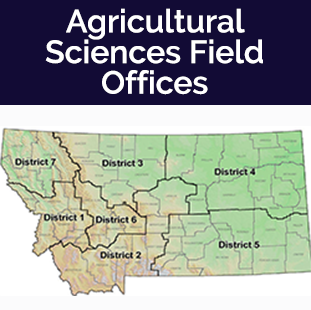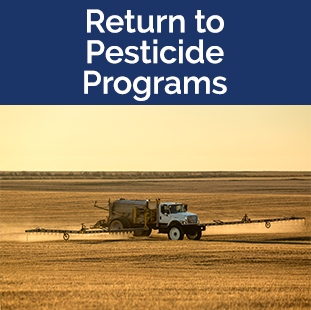The Montana Department of Agriculture offers compliance assistance and enforcement of the Montana Pesticide Act and associated administrative rules.
Pesticides are a tool to provide sufficient food quantity and quality, protect the environment from invasive or destructive species, and protect humans and animals from insect-borne diseases. Proper management is necessary for the protection of humans, animals, crops and the environment.
Investigations & Routine Inspections
The department strives to routinely inspect all licensed pesticide applicators and dealers on a 4- to 6-year basis and as needed to assure compliance with laws and regulations.
Department staff, with reasonable cause, may enter private premises and property with a warrant or with the owner's consent to inspect or investigate:
- Equipment for applying pesticides.
- Adverse effects on humans, crops, animals, land, or other property.
- Records on the sale, use or inventory of pesticides.
- Any person's handling, use, application, storage and disposal of pesticides including authority to collect needed samples of pesticides or crops.
- The environment alleged to have been exposed improperly to pesticides.
- Compliance with federal Worker Protection Standards.
- Compliance with licensing, labeling, permitting, and certification requirements.
Compliance Assistance
As part of a program that emphasizes voluntary inspections, the department may offer amnesty for certain compliance problems noted during routine inspections. The program emphasizes assistance to newly-regulated individuals or businesses, entities not previously inspected, and those subject to new regulations or new compliance initiatives. Assistance can involve:
- Providing education, training or outreach materials during a site visit.
- Providing formal education and materials to groups.
- Conducting compliance assistance inspections to eligible businesses or individuals.
Complaint Process
A person suffering loss or damage from the improper use of pesticides should file a report of loss (via telephone, email or written correspondence) with the department. Helpful information includes:
- Name and address of claimant.
- Type and location of property alleged to be injured or damaged.
- Date of the alleged injury or damage.
- Name of person thought to be responsible.
- Name of the property owner or occupant for whom the pesticide application was made.
Pesticide Spills
The department receives approximately 15-20 calls per year reporting pesticide spills. Only a few of those require an inspector to investigate. A person is required to report pesticide spills to the department or a field office within 48 hours if:
- The spill is 5 gallons or more, including formulated product, diluting agent and additives.
- The spill is 100 dry pounds or more, including formulated product, diluting agent and additives.
Information required when reporting a spill:
- Location of spill - legal description, address or landmarks
- Pesticide(s) name - manufacturer's name, EPA registration number
- Quantity spilled
- Name of primary contact including address and phone number
Control, Contain and Cleanup - The 3 C's:
- Control the pesticide spill by identifying the source and stopping the flow; wear proper personal protective equipment (PPE); and divert the spill away from water, wells, drains, sewers, etc.
- Contain the spill by building a dike with absorbent materials such as soil, sand, kitty litter, or a chemical absorbent tube sock. Never hose down the spill area until after clean up is complete.
- Clean up the pesticide spill by recapturing any usable material, absorbing residual liquid and, for contaminated soil, removing all damp soil plus 3 additional inches and contain the contaminated soil to prevent further contamination.
Proper Storage of Pesticides
Under state and federal law, all pesticide containers must be stored as directed by the product label. In addition, the department recommends:
- When feasible, the storage area should be in an area not subject to flooding but downwind and downhill from sensitive areas such as homes, play areas, feedlots, gardens and groundwater sources.
- Lock the storage area to prevent unauthorized access to pesticides and reduce the chance of accidental spills.
- Keep pesticides separate to prevent cross-contamination. Herbicides, insecticides, and fungicides should be stored on separate shelves or in separate areas.
- Keep large drums or bags on pallets and off the floor.
- Shelves for smaller containers should have lips to prevent containers from sliding off.
- Steel shelves are easier to clean than wooden ones if a spill occurs.
- Store dry products above liquids to prevent wetting from spills.
- Provide adequate road access for deliveries and emergency equipment.
- Post signs or labels to identify pesticide storage areas. Labels on the outside of the building assist firefighters if they must respond to a fire or a spill. It is also a good idea to separately keep a list of the products and amounts.


